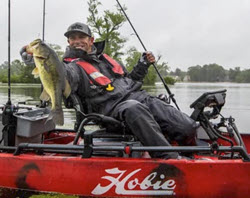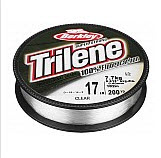
There are plenty of well-known wintertime bass techniques – things like fishing a jig or a blade bait or a spoon – and they all have their time and place, but recently I was reminded of one of the ones that hasn’t been explored quite as broadly. I call it “downstream deadsticking,” and while it’s not written about much (or precisely because no one’s discussing it), it can be one of the deadliest patterns any time you have cold water and current.
One of the reasons that it’s so hard for many anglers to grasp is because it flies in the face of one of the cardinal rules of fishing current. Since their earliest outings, anglers are taught to cast upstream and let the lure drift back down. It’s ingrained in all of us. This technique bucks that. You do exactly the opposite.
As I stated above, you generally need two conditions for this to work. The first is cool water, which is why it excels from late fall through early spring. The second is flow or current. That could be in a river, a stream, a tailrace, or even a reservoir when they’re moving a lot of water.

One of the reasons that it works so well in cold water is because that scenario bunches up the fish in their wintering holes. Usually, that’s someplace that’s just a little bit deeper. Last week I was successfully using this technique in 34- to 36-degree water on the Upper Susquehanna River for smallmouths, and those wintering holes were just a foot or two deep, but that was enough to congregate the fish. When you identify those spots, you need to hold your boat steady. In water under 8 or 10 feet deep, that means Power Poles, and in water deeper than that, you can use your trolling motor anchoring system. Alternatively, you can use a plain old anchor.

The craziest thing about this is the way you “work” the lure. You don’t do much at all! Just cast downstream, crank the lure five to ten times to get it in place, and then leave it there. Maybe every five or ten seconds, you give it a little twitch, but that’s it. The bass actually come and find it, and when they do, they hit it like there’s no tomorrow. After about a minute, I’ll make another cast, usually either 6 inches to the left or to the right of my last one. I want to “cut the pizza” into slices and cover the water gradually.
So you may have noticed that I didn’t mention any particular lures yet. I basically have two: a jerkbait and a crankbait, but the specific choices may surprise you. Normally in the wintertime, we go with a tight-wobbling, subtle jerkbait, like the Shadow Rap, but for this technique I prefer the X-Rap in the 4” or 4.75” sizes. Because I’m holding it in place, I want a slightly wider wobble than when I’m casting it and covering water. This is my typical choice in clear to slightly stained water.

In more stained water, like what you might find in a Tennessee river tailrace, I’ll choose a crankbait like the deeper-diving Rapala Brat. It’s not super-wide wobbling or super-tight wobbling. Instead, it’s just in the middle. The nice thing about this technique is that you really don’t need any special tackle for it. Just use the rod and reel you’d normally utilize with the lures listed above, and you’ll be fine. I do think that using fluorocarbon or monofilament (as opposed to braid) is absolutely necessary. I use fluoro most of the time because I feel like it maximizes my lure’s motion but still has adequate stretch for solid hook sets.

One final key: I use scent on my hard baits for this technique. That’s almost unheard of. All of us understand intuitively that there are times when scents like Gulp or Powerbait will increase your catch rate meaningfully when used on soft plastics. I’m here to tell you that because the lure stays in the same place. It’s true with hard baits in this scenario, too, especially when you’re fishing for smallmouths. On that recent Susquehanna trip, I outfished my partner 2:1 – same bait, same rod, same line, same everything, except I was applying scent and he wasn’t, and I truly believe that made the difference.
Give this technique a try the next time you’re out in a cold weather current situation. Your fishing partners may look at you like you’re crazy, but I guarantee there are times when nothing can beat it.


_____________________________________________________
Like Ike on Facebook, and follow him on Instagram and TikTok for fishing and fun content.
Subscribe to Mike’s YouTube channel, to ensure you see every adventure video. (Download the YouTube app on your phone and the videos will come to you automatically.)
Return to Mike Iaconelli’s website
















